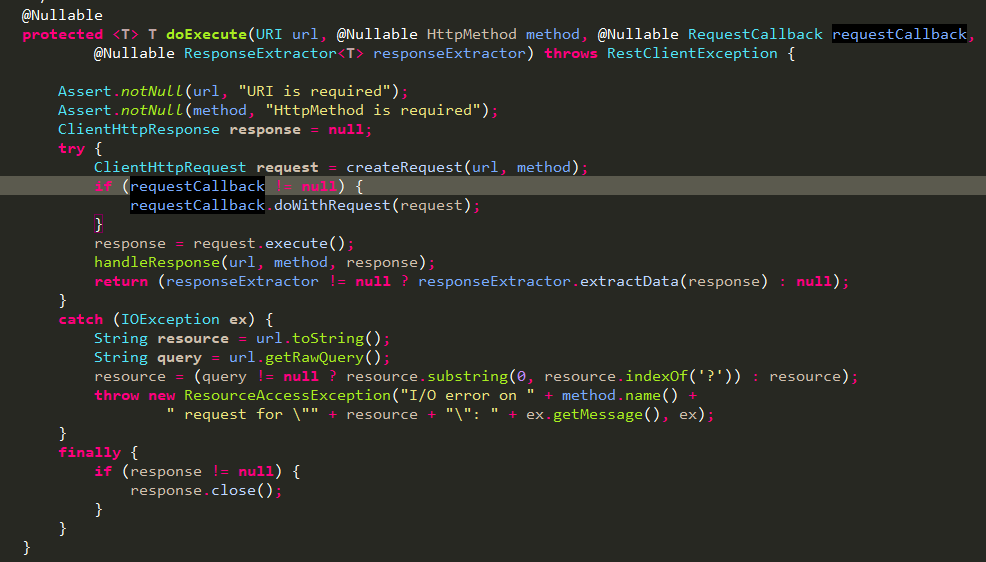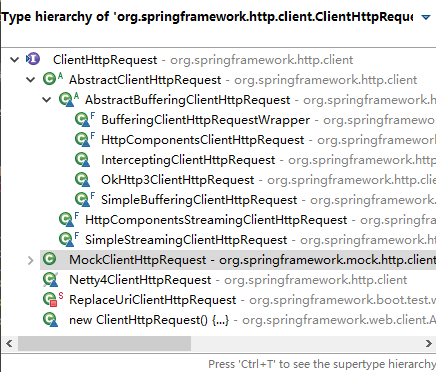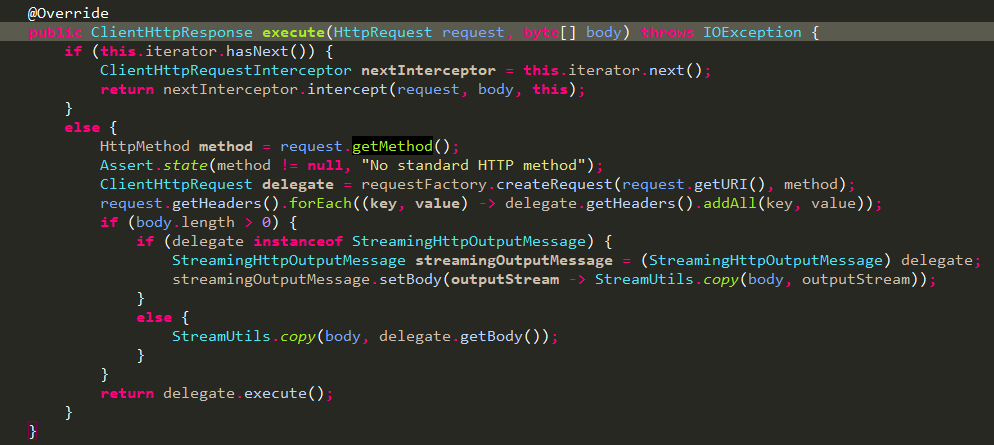核心方法为org.springframework.web.client.RestTemplate.doExecute(URI, HttpMethod, RequestCallback, ResponseExtractor<T>)
方法内容如下:

其中,重点在下面这三行:

ClientHttpRequest是http请求调用的抽象,具体实现有jdk自带的以及apache的httpclient,实现类如下:

simple开头的是使用jdk自带的net操作,Components的底层是httpclient操作。
AbstractBufferingClientHttpRequest为缓存requestbody的基类,内部bufferedOutput保存了requestbody的内容,避免流的二次读取会导致读取不到数据。
那么,到底是哪里给这个ByteArrayOutputStream对象赋值的呢?答案就在org.springframework.web.client.RestTemplate.HttpEntityRequestCallback,注释讲得很清楚:

在上面讲到的重点强调的三行代码中,调用了org.springframework.web.client.RestTemplate.HttpEntityRequestCallback.doWithRequest(ClientHttpRequest)方法,这个方法里面根据requestContentType等信息,在HttpMessageConverters列表中寻找合适的HttpMessageConverter,利用这些httpMessageConverter天然的write方法将requestBody的内容经过处理转换写入入参HttpOutputMessage对应的getBody方法返回的OutputStream流中。然而,我们这里的ClientHttpRequest接口继承自HttpOutputMessage,AbstractClientHttpRequest的getBody实现调用子类的getBodyInternal方法,重点来了,AbstractBufferingClientHttpRequest的getBodyInternal返回的就是bufferedOutput,也就是缓存的ByteArrayOutputStream。到这里,缓存的requestbody数据有了。再啰嗦一句,使用HttpEntityRequestCallback的都是post请求的,get请求用的AcceptHeaderRequestCallback。
那么,问题来了,什么情况下会用这个缓存数据呢?我们看下AbstractBufferingClientHttpRequest的子类就知道了。
这里,又要回到刚刚的三行重点代码,doExecute的时候调用createRequest方法返回ClientHttpRequest,实际调用父类方法org.springframework.http.client.support.HttpAccessor.createRequest(URI, HttpMethod):
org.springframework.http.client.support.InterceptingHttpAccessor.getRequestFactory()方法如下:

如果设置了拦截器就返回InterceptingClientHttpRequestFactory,并将restTemplete原有的RequestFactory作为参数传入。
该factory创建的是org.springframework.http.client.InterceptingClientHttpRequest,该类重写的executeInternal方法通过内部类InterceptingRequestExecution实现interceptors顺序执行,当迭代结束后,通过之前传进来的requestFactory创建ClientHttpRequest,并将body copy给刚刚创建的request的body,并调用execute方法,方法内容如下:

其实,InterceptingClientHttpRequest本身就带有requestbody缓存copy功能,所以无需在创建restTemplate时包装一个BufferingClientHttpRequestFactory,直接使用HttpComponentsClientHttpRequestFactory即可,这个factory自带bufferRequestBody功能。
相信大部分同学在项目中都是选择apache的httpclient发送http请求,所以,这里我们重点看下org.springframework.http.client.HttpComponentsClientHttpRequestFactory,我们看下createRequest方法:
public ClientHttpRequest createRequest(URI uri, HttpMethod httpMethod) throws IOException { HttpClient client = getHttpClient(); HttpUriRequest httpRequest = createHttpUriRequest(httpMethod, uri); postProcessHttpRequest(httpRequest); HttpContext context = createHttpContext(httpMethod, uri); if (context == null) { context = HttpClientContext.create(); } // Request configuration not set in the context if (context.getAttribute(HttpClientContext.REQUEST_CONFIG) == null) { // Use request configuration given by the user, when available RequestConfig config = null; if (httpRequest instanceof Configurable) { config = ((Configurable) httpRequest).getConfig(); } if (config == null) { config = createRequestConfig(client); } if (config != null) { context.setAttribute(HttpClientContext.REQUEST_CONFIG, config); } } // 默认情况下bufferRequestBody为true,创建使用缓存的body作为请求体 if (this.bufferRequestBody) { return new HttpComponentsClientHttpRequest(client, httpRequest, context); } else { return new HttpComponentsStreamingClientHttpRequest(client, httpRequest, context); } }
看下上面注释的类的下面方法org.springframework.http.client.HttpComponentsClientHttpRequest.executeInternal(HttpHeaders, byte[]):

这个类也是继承自AbstractBufferingClientHttpRequest,所以刚刚InterceptingRequestExecution迭代结束后getBody返回的就是缓存的bufferedOutput,到这里执行的时候就将bufferedOutput作为ByteArrayEntity发送http请求。至此,结束。